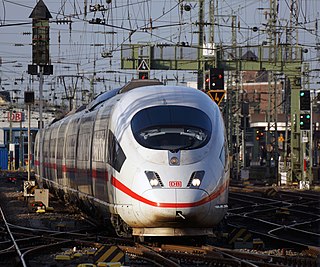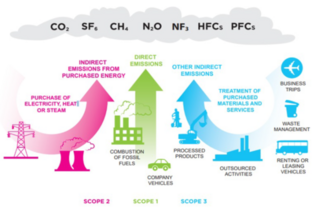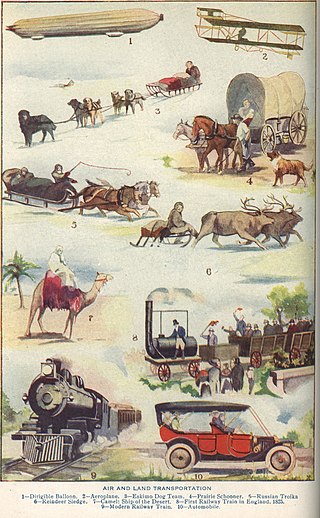Related Research Articles

Transport in the United Kingdom is highly facilitated by road, rail, air and water networks. Transport is a devolved matter with each of the countries of the United Kingdom having separate systems under separate governments.
The vast majority of passenger travel in the United States occurs by automobile for shorter distances and airplane or railroad for longer distances. Most cargo in the U.S. is transported by, in descending order, railroad, truck, pipeline, or boat; air shipping is typically used only for perishables and premium express shipments. Transportation is the largest source of greenhouse gas emissions in the United States.

The economy of France is a highly developed social market economy with notable state participation in strategic sectors. It is the world's seventh-largest economy by nominal GDP and the ninth-largest economy by PPP, constituting around 4% of world GDP. Due to a volatile currency exchange rate, France's GDP as measured in dollars fluctuates sharply. France has a diversified economy, that is dominated by the service sector, whilst the industrial sector accounted for 19.5% of its GDP and the primary sector accounted for the remaining 1.7%. In 2020, France was the largest Foreign Direct Investment recipient in Europe, and Europe's second largest spender in research and development. It was ranked among the 10 most innovative countries in the world by the 2020 Bloomberg Innovation Index, as well as the 15th most competitive nation globally according to the 2019 Global Competitiveness Report. It was the fifth-largest trading nation in the world. France is also the most visited destination in the world, as well as the European Union's leading agricultural power.

Logistics is a part of supply chain management that deals with the efficient forward and reverse flow of goods, services, and related information from the point of origin to the point of consumption according to the needs of customers. Logistics management is a component that holds the supply chain together. The resources managed in logistics may include tangible goods such as materials, equipment, and supplies, as well as food and other consumable items.

As of 2021, Germany had a railway network of 33,399 kilometres (20,753 mi), of which 20,540 kilometres (12,760 mi) were electrified and 18,556 kilometres (11,530 mi) were double track. Germany is a member of the International Union of Railways (UIC). The UIC Country Code for Germany is 80.
A green economy is an economy that aims at reducing environmental risks and ecological scarcities, and that aims for sustainable development without degrading the environment. It is closely related with ecological economics, but has a more politically applied focus. The 2011 UNEP Green Economy Report argues "that to be green, an economy must not only be efficient, but also fair. Fairness implies recognizing global and country level equity dimensions, particularly in assuring a Just Transition to an economy that is low-carbon, resource efficient, and socially inclusive."

SGS is a Swiss multinational company headquartered in Geneva, which provides inspection, verification, testing and certification services. Its 98,000 employees operate a network of 2,650 offices and laboratories worldwide. It ranked on Forbes Global 2000 in 2015, 2016, 2017, 2020 and 2021.

The carbon footprint (or greenhouse gas footprint) makes it possible to compare the total amount of greenhouse gases emitted from an activity, product, company or country. Carbon footprints are usually reported in tonnes of emissions (CO2-equivalent) per unit of comparison. Such units includes year, person, kilogram of protein and kilometer travelled. A product's carbon footprint includes the emissions for the entire life cycle. These run from the production along the supply chain to its final consumption and disposal. Similarly an organization's carbon footprint includes the direct as well as the indirect emissions that it causes. The Greenhouse Gas Protocol that is used for carbon accounting of organizations calls these Scope 1, 2 and 3 emissions. There are several methodologies and online tools to calculate the carbon footprint. They depend on whether the focus is on a country, organization, product or individual person. For example, the carbon footprint of a product could help consumers decide which product to buy if they want to be climate aware. For climate change mitigation activities, the carbon footprint can help distinguish those economic activities with a high footprint from those with a low footprint. So the carbon footprint concept allows everyone to make comparisons between the climate impacts of individuals, products, companies and countries. It also helps people devise strategies and priorities for reducing the carbon footprint.

Food miles is the distance food is transported from the time of its making until it reaches the consumer. Food miles are one factor used when testing the environmental impact of food, such as the carbon footprint of the food.

DB Cargo Polska is a Polish company operating mainly in rail freight transportation. It is presently owned by the German state railway company Deutsche Bahn (DB).

Carbon accounting is a framework of methods to measure and track how much greenhouse gas (GHG) an organization emits. It can also be used to track projects or actions to reduce emissions in sectors such as forestry or renewable energy. Corporations, cities and other groups use these techniques to help limit climate change. Organizations will often set an emissions baseline, create targets for reducing emissions, and track progress towards them. The accounting methods enable them to do this in a more consistent and transparent manner.

Greenhouse gas (GHG) emissions from human activities intensify the greenhouse effect. This contributes to climate change. Carbon dioxide, from burning fossil fuels such as coal, oil, and natural gas, is one of the most important factors in causing climate change. The largest emitters are China followed by the United States. The United States has higher emissions per capita. The main producers fueling the emissions globally are large oil and gas companies. Emissions from human activities have increased atmospheric carbon dioxide by about 50% over pre-industrial levels. The growing levels of emissions have varied, but have been consistent among all greenhouse gases. Emissions in the 2010s averaged 56 billion tons a year, higher than any decade before. Total cumulative emissions from 1870 to 2017 were 425±20 GtC from fossil fuels and industry, and 180±60 GtC from land use change. Land-use change, such as deforestation, caused about 31% of cumulative emissions over 1870–2017, coal 32%, oil 25%, and gas 10%.

Transport or transportation is the intentional movement of humans, animals, and goods from one location to another. Modes of transport include air, land, water, cable, pipelines, and space. The field can be divided into infrastructure, vehicles, and operations. Transport enables human trade, which is essential for the development of civilizations.

The economy of Lithuania is the largest economy among the three Baltic states. Lithuania is a member of the European Union and belongs to the group of very high human development countries and is a member of the WTO and OECD.

The environmental effects of transport are significant because transport is a major user of energy, and burns most of the world's petroleum. This creates air pollution, including nitrous oxides and particulates, and is a significant contributor to global warming through emission of carbon dioxide. Within the transport sector, road transport is the largest contributor to global warming.
Prospective Outlook on Long-term Energy Systems (POLES) is a world simulation model for the energy sector that runs on the Vensim software. It is a techno-economic model with endogenous projection of energy prices, a complete accounting of energy demand and supply of numerous energy vectors and associated technologies, and a carbon dioxide and other greenhouse gases emissions module.
Agility Public Warehousing Company K.S.C.P. is a publicly traded global company headquartered in Kuwait. Agility owns and operates businesses that include an aviation services company; industrial warehousing and logistics parks in the Middle East, South Asia, and Africa; a commercial real estate business developing a mega-mall in the UAE; a liquid fuel logistics business; and companies specializing in customs digitization, remote infrastructure services, e-commerce enablement, digital logistics, and more.

Lineas is the largest private rail freight operator in Europe. Headquartered in Belgium, it also operates from various sites across France, Germany, Italy, the Netherlands, and Spain. The Federal Holding and Investment Company holds 10% of the shares. Private equity group Argos Wityu and the management of Lineas together hold the remaining 90%.
Urban freight distribution is the system and process by which goods are collected, transported, and distributed within urban environments. The urban freight system can include seaports, airports, manufacturing facilities, and warehouse/distribution centers that are connected by a network of railroads, rail yards, pipelines, highways, and roadways that enable goods to get to their destinations.
Many countries offer subsidies to their railways because of the social and economic benefits that it brings. The economic benefits can greatly assist in funding the rail network. Those countries usually also fund or subsidize road construction, and therefore effectively also subsidize road transport. Rail subsidies vary in both size and how they are distributed, with some countries funding the infrastructure and others funding trains and their operators, while others have a mixture of both. Subsidies can be used for either investment in upgrades and new lines, or to keep lines running that create economic growth.
References
- ↑ "Transport sector economic analysis". EU Science Hub. Retrieved 27 June 2022.
- ↑ "Industry & Transport". IRENA – International Renewable Energy Agency. 21 February 2022. Retrieved 27 June 2022.
- ↑ "Sustainability in the transport and logistics industry". PwC. 12 May 2020. Retrieved 27 June 2022.
- ↑ Placek, Martin (6 December 2021). "Topic: Logistics industry worldwide". Statista. Retrieved 27 June 2022.
- ↑ Dowd, Kevin (13 May 2021). "Forbes Global 2000: The World's Largest Transportation Companies". Forbes. Retrieved 27 June 2022.
- ↑ "Largest transportation companies by market cap". CompaniesMarketCap.com. 9 October 2000. Retrieved 27 June 2022.
- ↑ "World Top Transportation Companies by Market Value 2022". World Top 1000 Companies by market value as on Jan 2022. 22 August 2020. Retrieved 27 June 2022.